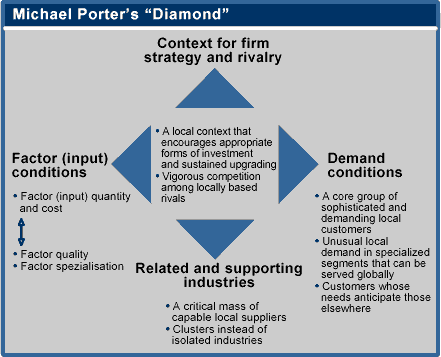Michael Porter's Diamond
The term competitive advantage was coined by Michael Porter in his work on firm-level factors (1986) and clusters of firms (1990). It marks a departure from traditional economic thinking which was focusing on comparative advantage. Essentially, comparative advantage is inherited (availability of basic factors of production, like cheap labor or energy, or natural resources) whereas competitive advantage is created. Looking back at the history of industrial development, one can perceive a series of firms, regions, and countries busily creating competitive advantage. Sustained industrial growth has hardly ever been built on inherited factors. As a rule is has been the outcome of interlinked factors and activities.
What are these interlinked factors? Porter himself boils it down to four factors which are summarized in the following figure.

- Business strategies and structures and rivalry: Porter notes that despite all differences and national peculiarities one characteristic shared by competitive economies is that there is sharp competition among national firms. In a static perspective, national champions may enjoy advantages of scale; but the real world is dominated by dynamic conditions, and here it is direct competition that impels firms to work for increases in productivity and innovation; here, anonymous competition often turns into concrete rivalries and feuds, in particular when competitors are spatially concentrated. "The more localized the rivalry, the more intense. And the more intense, the better." (Porter 1990, 83) This is all the more true, as its effect is to cancel out static locational advantages and compel firms to develop dynamic advantages.
- Existence or lack of related and supporting industries: Spatial proximity of upstream or downstream industries facilitates the exchange of information and promotes a continuous exchange of ideas and innovations. Porter refers, among other things, to experiences with industrial districts in Italy, whereby, however, he strongly qualifies their specifics (see below). On the one hand, he points out that even upstream industries should in no case be sheltered from international competition; and he notes on the other hand that when certain upstream industries are lacking, recourse can be had to the supply available in the world market.
- Factor conditions: These include, e.g. the availability of qualified manpower or adequate infrastructure. "Contrary to conventional wisdom, simply having a general work force that is high school or even college educated represents no competitive advantage in modern international competition. To support competitive advantage, a factor must be highly specialized to an industry’s particular needs - a scientific institute specialized in optics, a pool of venture capital to fund software companies. These factors are more scarce, more difficult for foreign competitors to imitate - and they require sustained investment to create." (Porter 1990, 78).
Here, disadvantages in general factor endowments need not necessarily prove disadvantageous, and they can even stimulate the development of competitiveness. If cheap raw materials or labor are available in abundance, firms will often yield to the temptation to rely solely on these advantages, and even to put them to inefficient uses. Conversely, certain disadvantages (high real estate prices, scarce labor and raw materials) can force firms to behave innovatively. This of course presupposes that positive impulses are generated by the other factors.- Demand conditions: The more demanding the customers in an economy, the greater the pressure facing firms to constantly improve their competitiveness via innovative products, through high quality, and so on. And the more localized the competition, the more directly firms feel it, and the better their performance has to be.